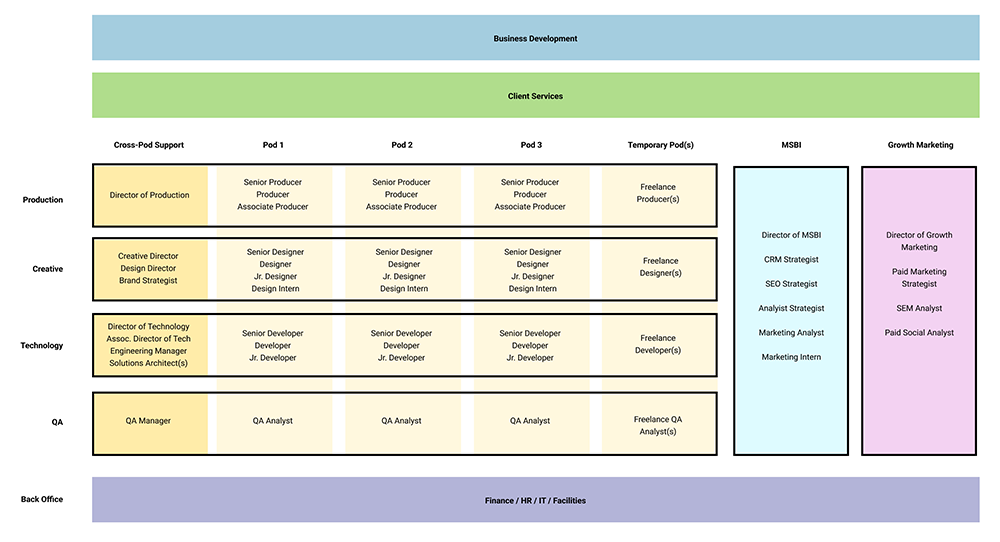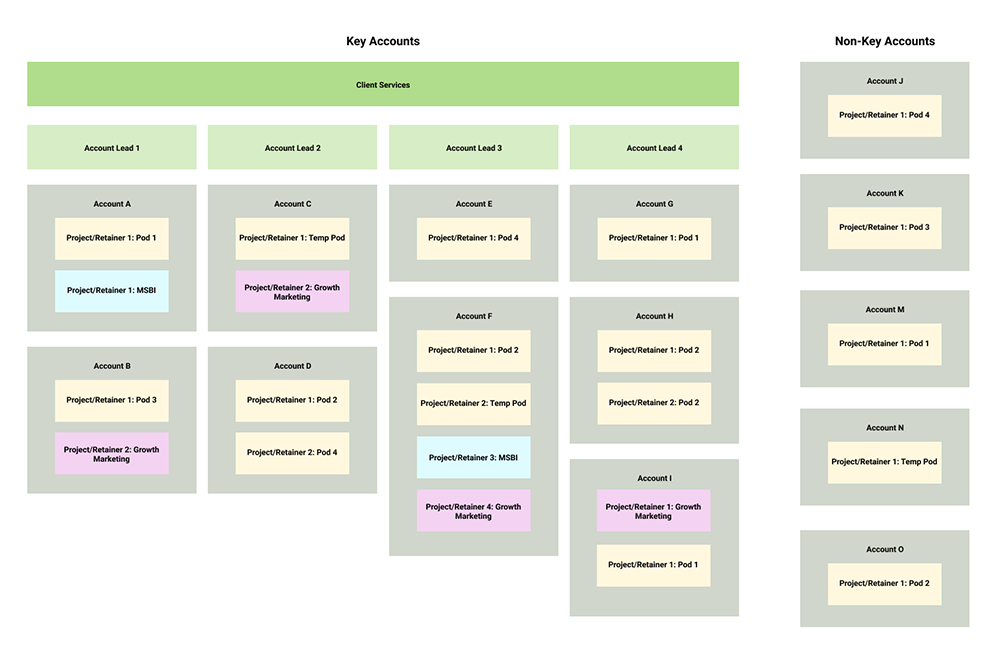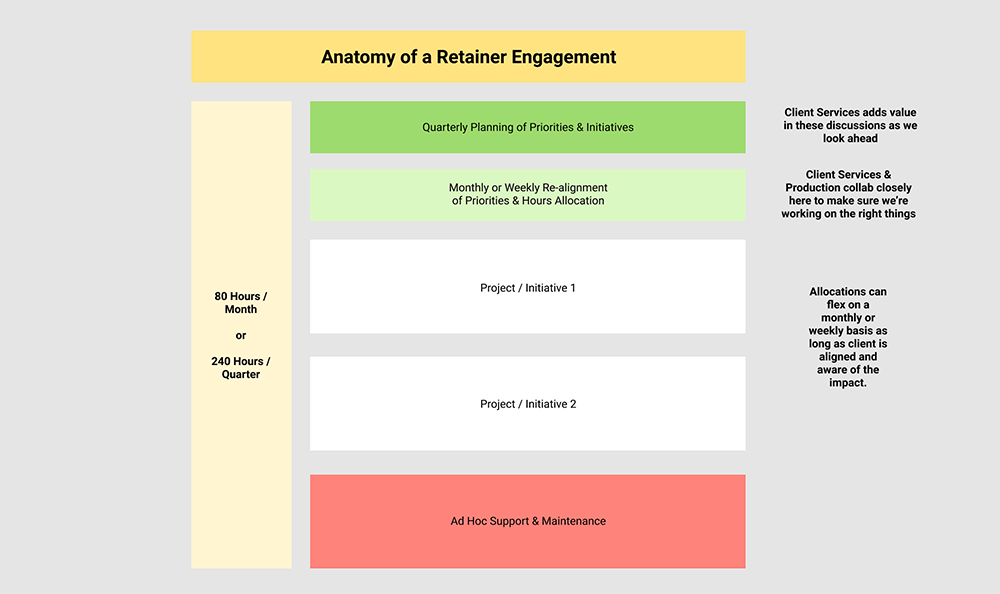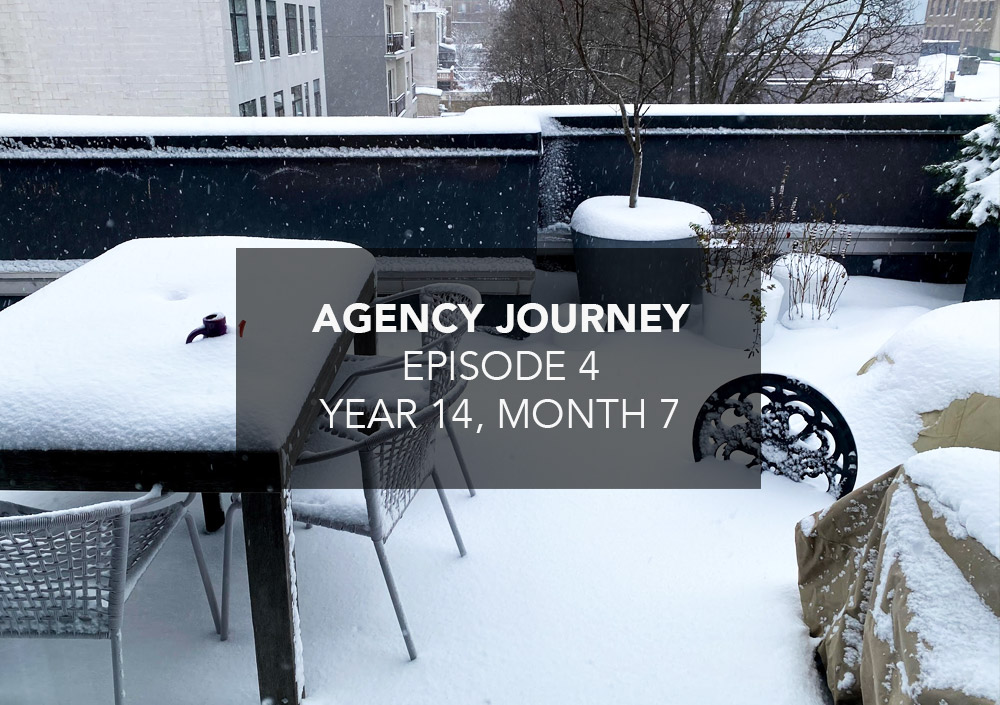One question that’s kept up coming up again and again in my mind the past few weeks has been: “Are we in a better place than we were a year ago?”
In other words, what kind of progress have we made?
One bit that’s been a damper towards the end of the year has been the slowed momentum in new business won and receivables collected in Q4. While we’ll finish the year slightly above where we were last year in terms of topline revenue and profit, the recent struggles have colored the lens through which I’ve felt about this year.
However, if I can see the glass as half-full for a minute, I think there are some really great wins worth celebrating. These wins include:
- Staying in business through a global pandemic and transitioning to a remote-first workplace
- Growing the team, hiring excellent new team members including some in key leadership positions, and making important promotions
- Landing several new clients and exciting high-impact projects
- Extending our contractor network at least threefold
- Expanding our services offering with deeper engagements in brand strategy, CRM, and SEO
- Growing our recurring revenue base through various retainer engagements
- Continually experimenting with and adapting our workflows and internal communications, learning what works and what needs further experimentation
- Making a commitment to work-life balance, team member experience, and being a family-friendly workplace–pleased we were able to roll out things like 401k matching, profit sharing, and all-year half-day Fridays
Okay, so we had a good year. I’m grateful for our team, our clients, and all the partners in our ecosystem for making things work in what was often a challenging time.
Whatever the final numbers on 2020 end up being, I believe we’re doing the right things to build momentum for the long run and establish a foundation to build a lasting and successful business. Truly excited for 2021.
On to episode 4.
About Agency Journey: This is a monthly series detailing the happenings of my agency Barrel, founded in 2006. You can find previous episodes here.
Highlights
New Business Wins Just in Time
I mentioned last month that new business activity was a bit slow. This continued to be the trend, which portended some challenges in the upcoming months, especially as we had projects scheduled to wrap up in January, opening up availability across the agency.
In the past, these situations would usually gnaw at me quite a bit and keep me pretty stressed out. While not completely free of stress, I’ve tried my best to be patient and calm this time around (with the exception that I was overly cynical and frustrated at times in private messages to my partners, who gratefully made me aware and helped me correct course). One of the things keeping me hopeful was the fact that we had so many opportunities on the cusp of being closed and signed. We also had a robust pipeline of new work with existing clients that just hadn’t yet been finalized and signed.
Last week, the last full week of the year before most folks take off the for the holidays, we finally closed on a handful of deals that will improve the financial outlook and keep us busy well beyond January. These include work for a direct-to-consumer meal replacement beverage brand, a media company focused on motherhood, an arts center in the Hudson Valley, and some Super Bowl-related work for an existing client.
I’m pretty excited and looking forward to what the team will produce for these clients. I’m also very motivated to continue building out better infrastructure to avoid these feast and famine scenarios with new business. This means strong marketing to raise awareness of our services and work, a strong outbound game to cultivate potential future leads (more on that below), a strong inbound game to qualify and quickly process leads, and an exceptional client services function to grow existing accounts. I see holes in our business development function and intend to fill these through better systems, new hires, and outside help.
Director of Client Services Hired
We finally filled the role of Direct of Client Services. She’s an experienced agency leader with a history of running not only the client services function but also overseeing agency-wide operations. We’re incredibly excited. More to come in the following months. She starts in January.
It’s been a long road in first envisioning the role and then interviewing numerous candidates to fill it. I’m glad we put in the effort and am grateful we found the right candidate.
Sales Schema Outbound Campaigns
In November, we engaged Sales Schema to kick off an ongoing outbound business development relationship to help us expand our network and cultivate more new business opportunities.
We’ve tried new biz consultants in the past and had been disappointed with the results. However, after having read Sales Schema founder Dan Englander’s book and listened to his Digital Agency Growth Podcast, I felt it would be worthwhile to at least learn more about their offering. After getting a better idea of how they worked, we decided to move forward.
A couple things are different this time around:
- I am now no longer day-to-day with the responsibilities of handling inbound leads and working to coordinate our business development activities. That’s now under the stewardship of our Director of Business Development Dan Fleishaker.
- I am a much more diligent person when it comes to my calendar, note-taking, and follow-ups having become a Getting Things Done convert with a better understanding of designing systems to facilitate success in any new initiative.
The combination of the above allowed me to embrace the Sales Schema outbound engagement with greater focus. I worked quickly to complete all the onboarding activities which included reviewing their cold outreach email script, reviewing a comprehensive Do Not Contact List, and providing work examples for prospects when necessary. In the past, these asks would have taken weeks if not months, but I tried to get these done within 24-48 hours at the latest.
The result is that we’ve been able to launch our first campaign fairly quickly targeting people in the Columbia University network (where I’m an alum) with a generic message about getting to know each other. So far I’ve taken 13 calls with folks from various industries and backgrounds. My goal is to do 4-6 calls like this per week and continue to expand my network.
The folks at Sales Schema advised me to keep an open mind and take calls that on the surface may not seem relevant. I’ve taken this to heart and try to prepare for every call as if I’m doing a podcast interview show, trying to research the other person and listing out some questions to get them talking. I tell myself that there’s no pressure to try to sell people on anything, and instead to focus on being a good listener and trying to be helpful where possible.
The goal, I hope, is to cultivate a handful of relationships over time that can eventually lead to real opportunities. But for now, I’m trying to embrace the process and put in the time each week. We’ve committed for at least 6 months, and I’m optimistic that if the pace of call activity continues, we’ll see some real results by then.
Top of Mind
Thinking About Business Structure
We continued to evolve and tweak various aspects of our business structure with an eye towards improving the client experience and also making our operations more efficient and scalable.
One initiative that began this year and is continuing to take root within the org is our pod system for resourcing project teams. A pod consists of a multi-disciplinary configuration of personnel that doesn’t change. Rather than assign an ad hoc mix of available talent to projects from across the entire agency, we instead assign a pod to a new project and figure out who from that pod can do the work.
The original reason for the pod approach was to simplify resourcing challenges and reduce the coordination complications that arise with scheduling when people are staffed on multiple projects. By limiting project staffing to pods, the bulk of the coordination happens within the pod.

A diagram illustrating how we’re thinking about the pod model at Barrel.
We also believe that over time, the number of reps that pod members get working on projects together will have certain benefits and the ability to cover for each other across different projects within the pod will offer a degree of redundancy.
The roll-out of the pod-based model hasn’t been the smoothest. I blame myself for not quite nailing the communication and alignment with team leaders as well as being subpar with accompanying the roll-out with effective visuals and documentation. I’ve devoted more time in recent weeks to correcting this and have made much progress. I’m already having more productive conversations with people and able to tweak and clarify the model on the fly as I get more feedback.
The other structure-related work that’s been top of mind for me is around the way accounts are managed at Barrel. We’ve adopted the idea of Key Accounts–accounts that are geared towards a long-term relationship with repeat engagements–and assigned account leads to oversee the growth of these relationships. This means figuring out which clients are Key Accounts and which are not. We’re still in the process of fully defining the criteria to help us make the determination.
The immediate benefit of this structure is that it will eliminate the vagueness and strain that comes from not knowing how to deal with clients who go from having done one project to quickly ramping up to have multiple engagements going on at the same time. We’ve often struggled at this and have disappointed both clients and ourselves by lacking a proper approach. I’m hoping our account leads, with their “portfolio of accounts” can help us more reliably generate growth from existing client relationships.

A diagram to show how we’re thinking about Key Accounts vs. Non-Key Accounts.
I would add that this is just the start to really fleshing out our account management / client services model. I anticipate our new Director of Client Services will take the lead in bringing additional ideas and perspectives to this process.
Writing Down Thoughts, Visualizing Ideas
One of the challenges I’ve noticed is that on Zoom calls at Barrel, people rely heavily on talking to convey concepts and ideas but are less likely to bring up visuals to supplement. The exception is when it’s a prepared presentation, but these often tend to be lecture-style talks vs. interactive discussions.
I’ve always been a frequent whiteboarder. Pre-pandemic, I was fond of using our IdeaPaint-covered walls at the office during most meetings. As the pandemic forced all meetings onto Zoom, it took me a while to realize that many ideas, concepts, and plans were often misinterpreted or confused when explained solely through speech. Even when people followed up with messages in Slack or email, the written word was often not enough.
I think there’s something to be said about the effectiveness of diagrams and drawings when it comes to people’s ability to pick up on complex concepts and models. I often think about the wonderful diagrams by Ben Thompson on his Stratechery site and how they’ve helped me to understand things like Aggregation Theory and the business models of different media and tech companies. Without them, I would have had a hard time remembering much of the ideas that Thompson has written about.

An example of a diagram I drew during a meeting to explain how we ought to visualize our monthly/quarterly “bucket of hours” that our clients sign.
With this in mind, I’ve promised myself and urged my partners to default more to diagramming, drawing, and using visuals in general as much as possible. We need to build this muscle to better communicate our ideas, and the more reps we get, the better we’ll become at developing our own visual language.
For me personally, I’ve become enamored with Figma because it reminds me of Adobe Illustrator and gives me the flexibility to quickly draw boxes and arrows. I love the collaborative capabilities, which lets others jump in and play around with me. I’m looking forward to making the use of Figma a daily supplement in my conversations with people.
Shared with Partners
“Not enough is said about the power of thinking about one topic for a long period of time. If you revisit a topic continually for a few years, most problems (and many solutions) will occur to you at some point. Expertise can be the gradual accumulation of many modest insights.” – James Clear
Over the years, we’ve revisited topics like business development, talent, resourcing, leadership, and organizational communication over and over again and there are always new discoveries both in the form of problems and solutions. The knowledge definitely does accumulate and some of these topics have become passionate studies for me personally.
“Happiness is really just about four things: perceived control, perceived progress, connectedness (number and depth of your relationships), and vision/meaning (being part of something bigger than yourself).” – Tony Hsieh, Delivering Happiness
RIP to Tony Hsieh, who tragically passed away in late November. I remember being inspired by Delivering Happiness in the early days of Barrel and hoping to one day create a culture I could be proud of. His definition of happiness still resonates.
“A great work ethic isn’t about working whenever you’re called upon. It’s about doing what you say you’re going to do, putting in a fair day’s work, respecting the work, respecting the customer, respecting coworkers, not wasting time, not creating unnecessary work for other people, and not being a bottleneck. Work ethic is about being a fundamentally good person that others can count on and enjoy working with.” (Jason Fried, David Heinemeier Hansson, It Doesn’t Have to Be Crazy at Work)
I think we’ve inadvertently linked Focus & Discipline, one of our core values, to the behavior of people getting things done, often at the expense of putting in long work hours. This has sometimes manifested as a celebration of “great work ethic” when people praise each other. But as the quote above suggests, putting in long hours in and of itself is no cause for celebration. It’s about following through on commitments, being a good team member, and working in a smart manner. We’ll have to do a better job of framing Focus & Discipline and also this notion of a work ethic.
“The ultimate sign of continuous improvement is the boutique’s client roster. For instance, three years ago a boutique attracted struggling clients. These struggling clients hired the boutique because the prestigious firms would not work with them. Today the boutique’s clients are household brand names. The best clients hire the boutique because it says something about them when they do. Client quality is the purest sign of continuous improvement.” (Greg Alexander, The Boutique)
This quote stuck with me because I agree with it whole-heartedly but it’s not something I’ve look at in detail when it comes to Barrel. I’ve assumed that over time, we’ve leveled up our client roster bit by bit. As an exercise, I pulled up the top 25 clients by revenue per year for the past 15 years. It was a nice walk down memory lane pulling up names of our earliest clients, our lucky breaks, and the relationships that allowed us to get to where we are today.

A side-by-side listing of the top 25 clients by revenue for the past 15 years at Barrel.
It felt great to confidently say to myself that our client roster at the end of 2020 is the strongest it’s ever been in the history of our company, and I know we’re just getting started. It’s not just about the prestige or size of the client on the list but the type of work we’re doing for them that I’m very proud of. We’ve come a long way.
Happy holidays, and best wishes for a great 2021.
